Health
Asneezia, Part 2
Two weeks ago I posted about 'Asneezia,' which was the name that a doctor in India (G.D. Shukla) gave to the condition of being unable to sneeze. His non-sneezing patients also suffered from mental illness. He published his report about Asneezia in 1985.I was somewhat skeptical about the reality of Asneezia. But yesterday, purely by chance, I came across the newspaper story below from 1958 about doctors at a New England psychiatric hospital who noted the odd fact that their patients never suffered from allergies, and so never sneezed. "If you hear a sneeze," one of them said, "you can know it's a staff member's."
As far as I know, Dr. Shukla (reporting about Asneezia in 1985) was unaware of this earlier report from 1958. But having two independent reports of a connection between not-sneezing and mental illness, from different times and different cultures, would seem to confirm the reality of the condition.
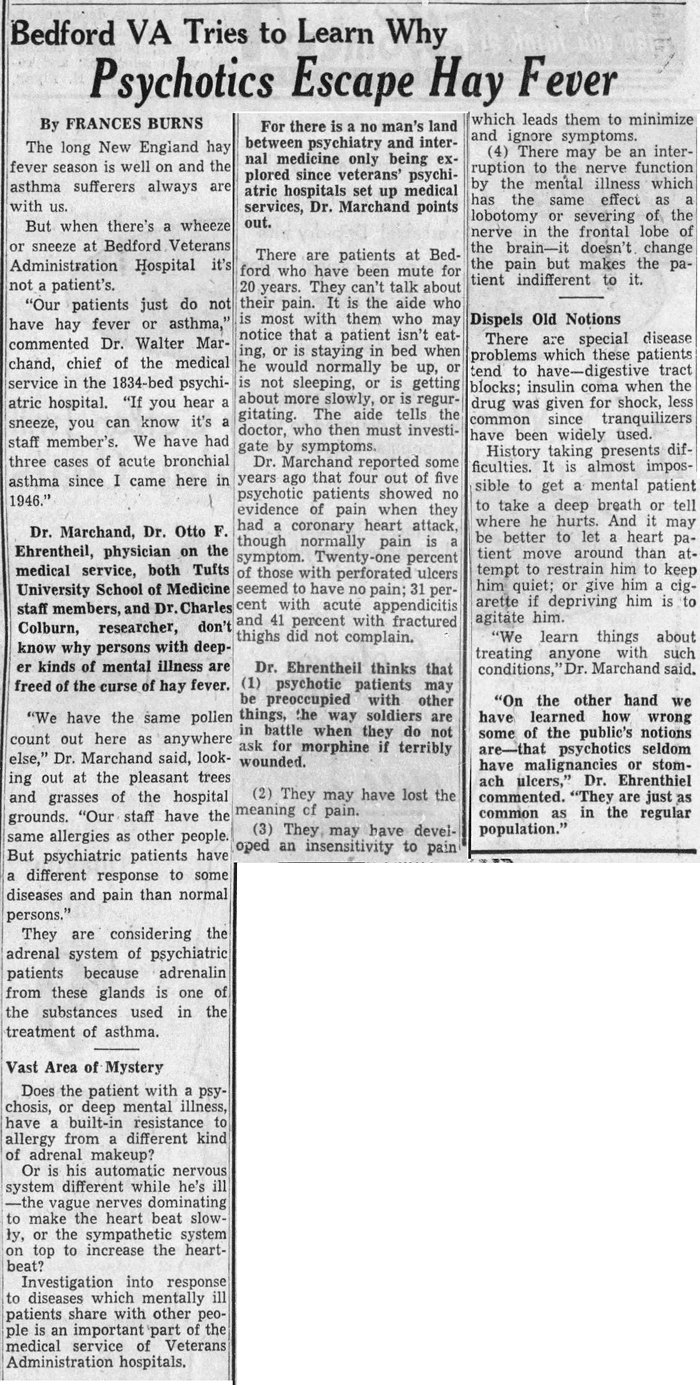
Boston Globe - June 16, 1958
Posted By: Alex - Mon Nov 07, 2022 -
Comments (0)
Category: Health, Mental Health and Insanity
Asneezia
In a 1985 report published in the British Journal of Psychiatry, Dr. G.D. Shukla brought a new condition to the attention of the medical community — the inability to sneeze. He named this 'Asneezia'. The sufferers were 'Asneezics'. His original article is behind a paywall, but a summary from Brain/Mind Bulletin is below: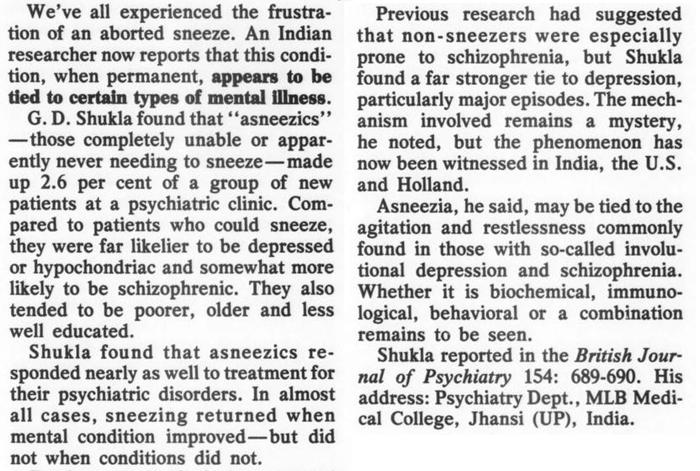
Brain/Mind Bulletin - July 1990
Later correspondents to the British Journal of Psychiatry were skeptical. One questioned whether Shukla's patients really suffered from this condition, or if they were simply delusional. Another proposed verifying the reality of Asneezia by exposing patients to "the most noxious inhalant allergen."
Posted By: Alex - Fri Oct 21, 2022 -
Comments (2)
Category: Health, Psychology
The Health Dangers of Sleeping on a Hartmann Line
My Great Aunt recently died at the age of 100. Throughout her life she was very much into alternative medicine, and she kept hundreds of newsletters from various alt-health practitioners. Most of them aren't particularly interesting, but while going through her stuff I've found a few oddities, such as a 1990 newsletter warning of the danger of sleeping on Hartmann Lines.I'd never heard of Hartmann Lines. Wikipedia describes them as "a scientifically unproven grid of invisible energy lines of the Earth's inherent radiation".
But how to know if you're sleeping on a Hartmann line? Well, if you've got a cat and it likes to sleep in your bed, you may be in trouble because apparently cats love sleeping on Hartmann lines. (I'm in trouble!)
I've posted a few snippets from the newsletter below, and also uploaded the full newsletter as a pdf file.
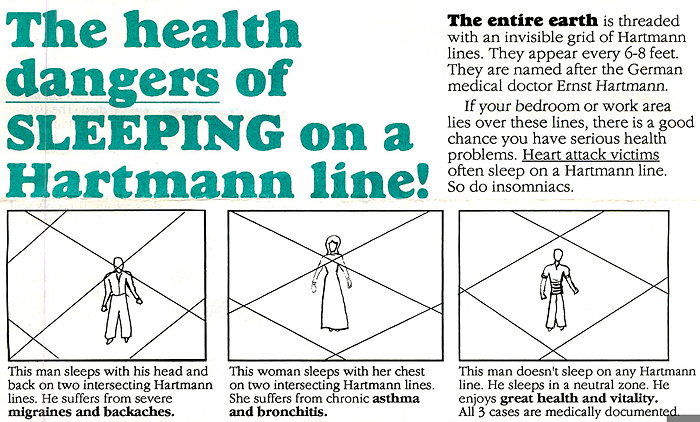
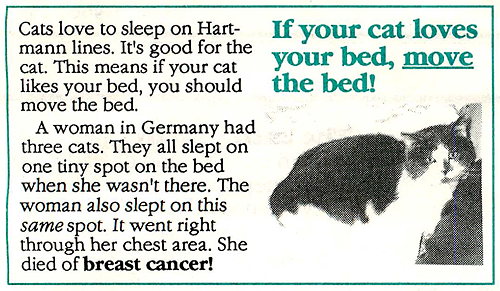

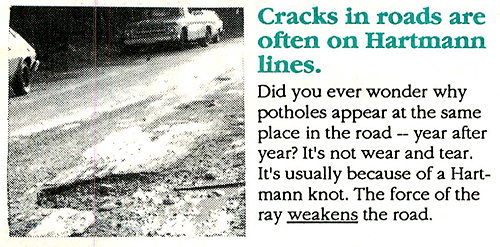
Posted By: Alex - Tue May 24, 2022 -
Comments (4)
Category: Health, Patent Medicines, Nostrums and Snake Oil, Cats
An unusual rectal foreign body
An article recently published in the International Journal of Surgery Case Reports describes the case of an unusual foreign body (a dumbbell) removed from a patient's rectum. It also provides a brief overview of the phenomenon of unusual foreign bodies that end up in rectums:
Posted By: Alex - Sat Apr 23, 2022 -
Comments (1)
Category: Health, Surgery, Sex Toys
Hit Hand, Regained Sight
June 1955: Peter Barr struck the palm of his left hand with his right fist to stress a point while arguing with his wife. And suddenly he was able to see again. He had been completely blind for three years.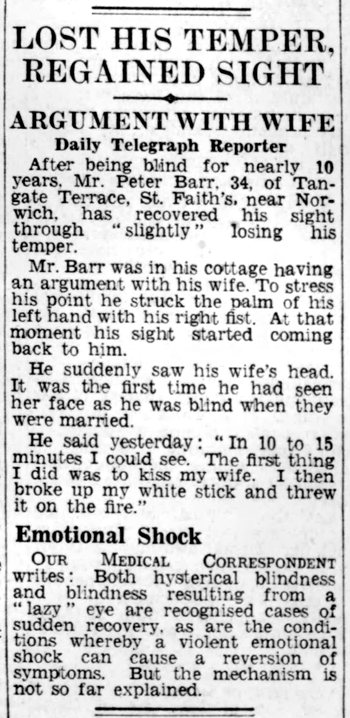
London Daily Telegraph - June 3, 1955
Other cases of accidental cures we've previously posted about:
- the man who regained his sight after a fall
- the woman whose sneeze cured her deafness
- The man whose blindness, deafness, and baldness was cured by lightning
- Blind Man Spontaneously Regains Sight After 30 Years
Posted By: Alex - Sat Apr 16, 2022 -
Comments (2)
Category: Health, 1950s, Eyes and Vision
Pneumonia Blouse
In the early twentieth century, women began wearing low-necked, gauzy blouses. Conservative critics branded them "pneumonia blouses" — warning that they would cause the women wearing them to catch pneumonia.More info: Jonathan Walford's blog

Example of a pneumonia blouse
Source: Holly Vogue Vintage
I often see young women out and about, dressed completely inappropriately for the cold weather, suffering for the sake of fashion. So the spirit of the pneumonia blouse seems to be alive and well, if not the specific style.
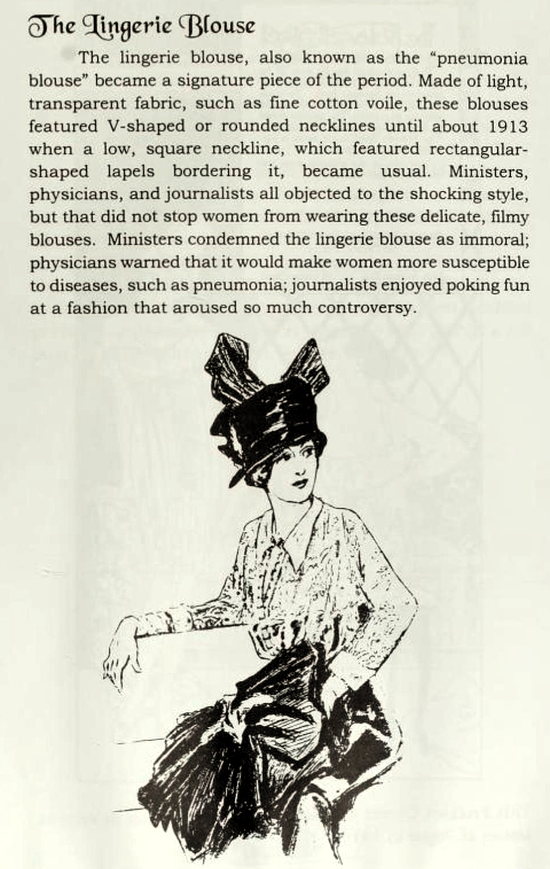
Victorian to Vamp: Women's Clothing 1900-1929, by Paula Jean Darnell
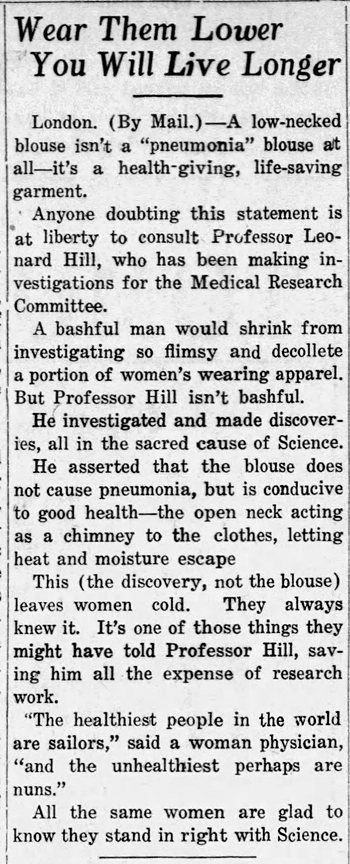
University Daily Kansan - Mar 18, 1920
Posted By: Alex - Sat Feb 05, 2022 -
Comments (3)
Category: Fashion, Health, 1900s
The Artesian Tree
I can find no fuller account of this miracle. No doubt it was bulldozed long ago.ADDENDUM: I just did the obvious and visited the address given via Google Streetview. No sign of the fabled tree, alas. See screenshot in extended.
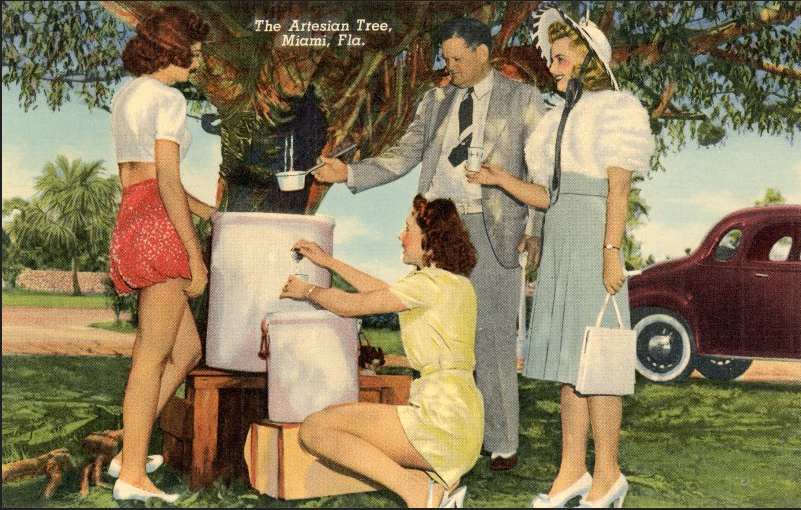
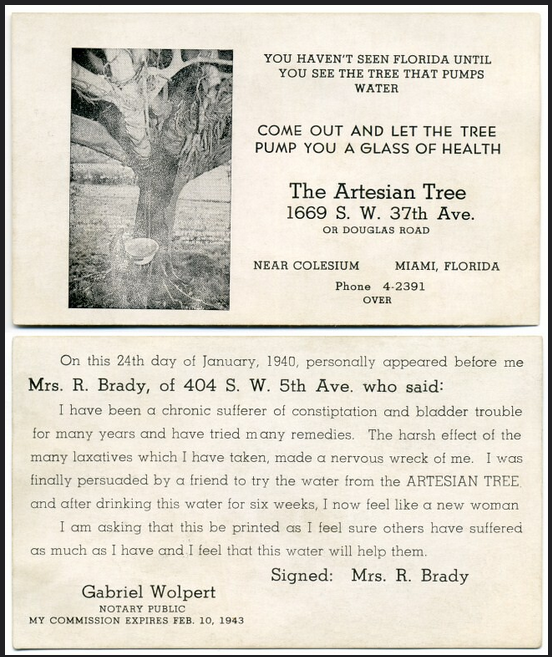
More in extended >>
Posted By: Paul - Sat Jan 15, 2022 -
Comments (4)
Category: Health, Regionalism, Natural Wonders
The Patented Carrot Rectal Dilator
In 1927, the Canadian patent office granted an unusual patent (CA 259317) to George L. Kavanagh. It was unusual because, while most patents describe some new type of gadget or gizmo, Kavanagh's invention simply consisted of a method of using a carrot.The problem Kavanagh had set out to solve was that of constipation in the elderly. The way he saw it, our rectums tend to grow more inelastic and shrunken as we age, and this leads to constipation. The solution, he concluded, was "gently dilating the anus and rectum until the organs are restored to their youthful size."
But what could be used as a dilator? Preferably something inexpensive and readily obtainable. That made him think of carrots.
A summary from his patent:

An added benefit of carrots, he noted, was that they come in a variety of different sizes. This would allow one to start with small carrots and work up to larger ones "until the desired result is obtained."
Unfortunately, Kavanagh submitted no drawings with his patent. But I did find a chart that provides a size comparison of different types of carrots, which could be potentially useful for anyone who wants to try out Kavanagh's method at home on an elderly relative.

image source: 123rf.com
Update: Kavanagh also got a US Patent (No. 1,525,505) for his invention.
Posted By: Alex - Wed Nov 24, 2021 -
Comments (3)
Category: Health, Inventions, Patents, Vegetables, 1920s
Device to prevent mouth breathing
In 1920, Richard Jefferies was granted a patent for "a simple and practical device which will eliminate the habit of breathing through the mouth and at the same time will assist in harmonizing the facial features of the wearer, by more evenly balancing the muscles of expression."His invention consisted of a piece of adhesive-backed silk placed over the mouth.
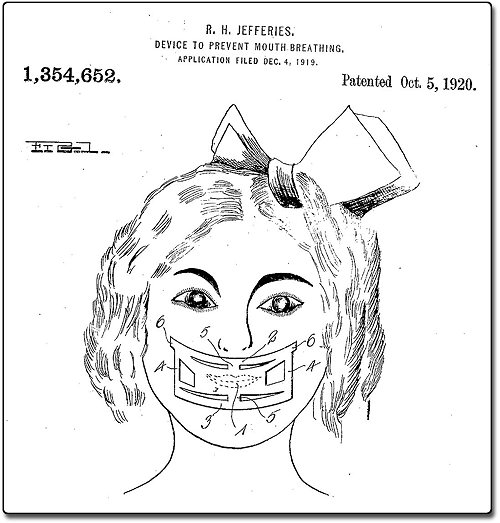
I was vaguely aware that mouth breathing is considered a bad habit, but I wasn't aware that "mouth taping" continues to be a common remedy for it.
For instance, one can buy SomniFix Sleep Strips, which look like they're a slightly updated version of Jefferies' invention.

Posted By: Alex - Wed Oct 27, 2021 -
Comments (1)
Category: Health, Inventions, Patents, 1920s, Face and Facial Expressions
Mask for smokers
Back in 1919, Edward T. Duncan solved the problem of how to smoke and wear a mask at the same time.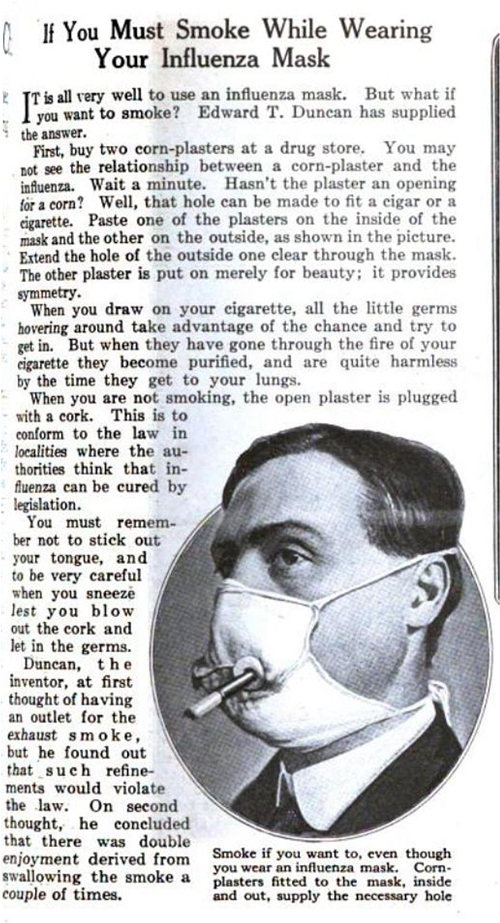
Popular Science Monthly - May 1919
The only modern near-equivalent I can find is a mask that jokes about having a "smoke hole," without actually having one.

Posted By: Alex - Fri Aug 20, 2021 -
Comments (1)
Category: Health, Smoking and Tobacco, 1910s

| Who We Are |
|---|
| Alex Boese Alex is the creator and curator of the Museum of Hoaxes. He's also the author of various weird, non-fiction, science-themed books such as Elephants on Acid and Psychedelic Apes. Paul Di Filippo Paul has been paid to put weird ideas into fictional form for over thirty years, in his career as a noted science fiction writer. He has recently begun blogging on many curious topics with three fellow writers at The Inferior 4+1. Contact Us |




